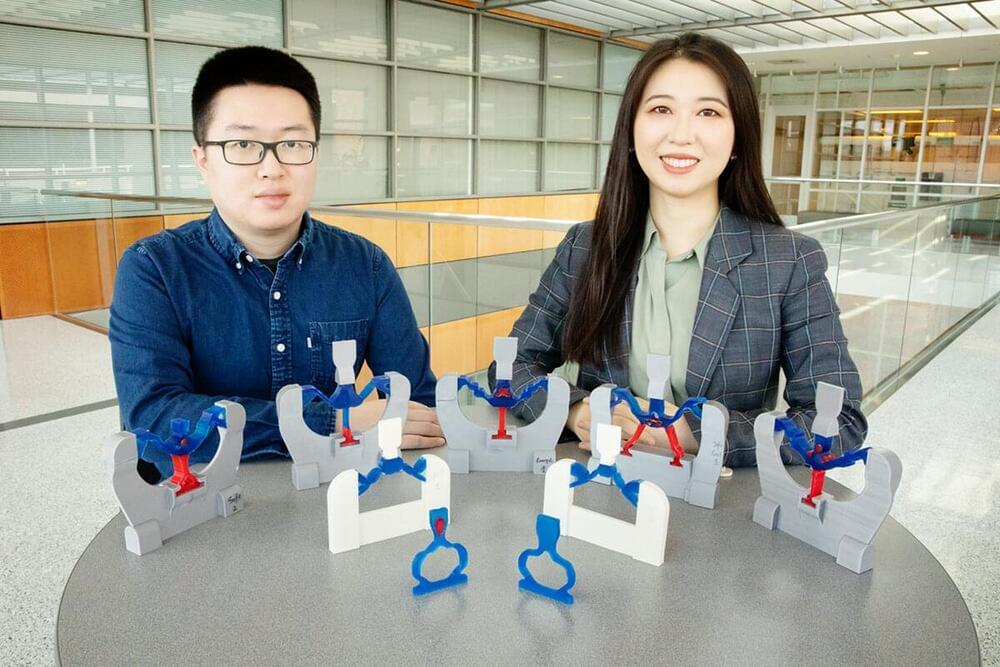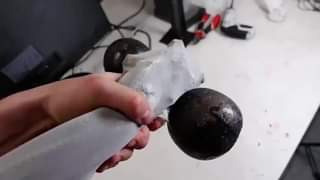Page 4984
Mar 3, 2022
Novel design greatly improves output from commercial circuit boards next to superconducting qubits
Posted by Chima Wisdom in categories: computing, quantum physics
Researchers at the National Institute of Standards and Technology (NIST) have constructed and tested a system that allows commercial electronic components—such as microprocessors on circuit boards—to operate in close proximity with ultra-cold devices employed in quantum information processing. That design allows four times as much data to be output for the same number of connected wires.
In the rising excitement about quantum computing, it can be easy to overlook the physical fact that the data produced by manipulation of quantum bits (qubits) at cryogenic temperatures a few thousandths of a degree above absolute zero still has to be initiated, read out, and stored using conventional electronics, which presently work only at room temperature, several meters away from the qubits. This separation has obstructed development of quantum computing devices that outperform their classical counterparts.
That extra distance between the quantum computing elements and the external electronics requires extra time for signals to travel, which also causes signals to degrade. In addition, each (comparatively very hot) wire needed to connect the electronics to the cryogenic components adds heat, making it hard to maintain the ultracold temperature required for the quantum devices to work.
Mar 3, 2022
Team develops fingertip sensitivity for robots
Posted by Chima Wisdom in categories: information science, robotics/AI

In a paper published on February 23, 2022 in Nature Machine Intelligence, a team of scientists at the Max Planck Institute for Intelligent Systems (MPI-IS) introduce a robust soft haptic sensor named “Insight” that uses computer vision and a deep neural network to accurately estimate where objects come into contact with the sensor and how large the applied forces are. The research project is a significant step toward robots being able to feel their environment as accurately as humans and animals. Like its natural counterpart, the fingertip sensor is very sensitive, robust, and high-resolution.
The thumb-shaped sensor is made of a soft shell built around a lightweight stiff skeleton. This skeleton holds up the structure much like bones stabilize the soft finger tissue. The shell is made from an elastomer mixed with dark but reflective aluminum flakes, resulting in an opaque grayish color that prevents any external light finding its way in. Hidden inside this finger-sized cap is a tiny 160-degree fish-eye camera, which records colorful images, illuminated by a ring of LEDs.
Continue reading “Team develops fingertip sensitivity for robots” »
Mar 3, 2022
Using artificial intelligence to find anomalies hiding in massive datasets
Posted by Chima Wisdom in category: robotics/AI
Identifying a malfunction in the nation’s power grid can be like trying to find a needle in an enormous haystack. Hundreds of thousands of interrelated sensors spread across the U.S. capture data on electric current, voltage, and other critical information in real time, often taking multiple recordings per second.
Researchers at the MIT-IBM Watson AI Lab have devised a computationally efficient method that can automatically pinpoint anomalies in those data streams in real time. They demonstrated that their artificial intelligence method, which learns to model the interconnectedness of the power grid, is much better at detecting these glitches than some other popular techniques.
Because the machine-learning model they developed does not require annotated data on power grid anomalies for training, it would be easier to apply in real-world situations where high-quality labeled datasets are often hard to come by. The model is also flexible and can be applied to other situations where a vast number of interconnected sensors collect and report data, like traffic monitoring systems. It could, for example, identify traffic bottlenecks or reveal how traffic jams cascade.
Mar 3, 2022
Clues to better batteries emerge from tracking lithium
Posted by Chima Wisdom in categories: chemistry, sustainability, transportation
Pure lithium metal is a promising replacement for the graphite-based anodes currently used in electric vehicle batteries. It could tremendously reduce battery weights and dramatically extend the driving range of electric vehicles relative to existing technologies. But before lithium metal batteries can be used in cars, scientists must first figure out how to extend their lifetimes.
A new study led by Peter Khalifah—a chemist at the U.S. Department of Energy’s (DOE) Brookhaven National Laboratory and Stony Brook University—tracked lithium metal deposition and removal from a battery anode while it was cycling to find clues as to how failure occurs. The work is published in a special issue of the Journal of the Electrochemical Society honoring the contributions of Nobel Prize-winning battery researcher John Goodenough, who like Khalifah is a member of the Battery 500 Consortium research team.
“In a good battery, the rate of lithium plating (deposition) and stripping (removal) will be the same at all positions on the surface of electrodes,” Khalifah said. “Our results show that it’s harder to remove lithium at certain places, which means there are problems there. By identifying the cause of the problems, we can figure out how to get rid of them and make better batteries with higher capacities and longer lifetimes.”
Mar 3, 2022
New approach to flexible robotics and metamaterials design mimics nature, encourages sustainability
Posted by Chima Wisdom in categories: information science, robotics/AI, sustainability

A new study challenges the conventional approach to designing soft robotics and a class of materials called metamaterials by utilizing the power of computer algorithms. Researchers from the University of Illinois Urbana-Champaign and Technical University of Denmark can now build multimaterial structures without dependence on human intuition or trial-and-error to produce highly efficient actuators and energy absorbers that mimic designs found in nature.
The study, led by Illinois civil and environmental engineering professor Shelly Zhang, uses optimization theory and an algorithm-based design process called topology optimization. Also known as digital synthesis, the design process builds composite structures that can precisely achieve complex prescribed mechanical responses.
Mar 3, 2022
Oil prices are rising fast. Saudi Arabia may not come to the rescue
Posted by Chima Wisdom in category: energy
A global hunt for spare barrels of crude is underway as sanctions slam Russia, the world’s second largest exporter, following its invasion of Ukraine.
But don’t expect Saudi Arabia to step in to fill the gap, at least for now.
What’s happening: The kingdom could help ease global oil prices, which have spiked to their highest level since 2014. Saudi Arabia has the capacity to raise production by 2 million barrels per day, according to Claudio Galimberti, senior vice president of analysis at Rystad Energy.
Mar 3, 2022
Study reveals chemical link between wildfire smoke and ozone depletion
Posted by Chima Wisdom in categories: chemistry, particle physics
The Australian wildfires in 2019 and 2020 were historic for how far and fast they spread, and for how long and powerfully they burned. All told, the devastating “Black Summer” fires blazed across more than 43 million acres of land, and extinguished or displaced nearly 3 billion animals. The fires also injected over 1 million tons of smoke particles into the atmosphere, reaching up to 35 kilometers above Earth’s surface — a mass and reach comparable to that of an erupting volcano.
Now, atmospheric chemists at MIT have found that the smoke from those fires set off chemical reactions in the stratosphere that contributed to the destruction of ozone, which shields the Earth from incoming ultraviolet radiation. The team’s study, appearing this week in the Proceedings of the National Academy of Sciences, is the first to establish a chemical link between wildfire smoke and ozone depletion.
In March 2020, shortly after the fires subsided, the team observed a sharp drop in nitrogen dioxide in the stratosphere, which is the first step in a chemical cascade that is known to end in ozone depletion. The researchers found that this drop in nitrogen dioxide directly correlates with the amount of smoke that the fires released into the stratosphere. They estimate that this smoke-induced chemistry depleted the column of ozone by 1 percent.
Mar 3, 2022
Researchers establish first-of-its-kind framework to diagnose 3D-printing errors
Posted by Chima Wisdom in categories: 3D printing, media & arts, robotics/AI
Additive manufacturing, or 3D printing, can create custom parts for electromagnetic devices on-demand and at a low cost. These devices are highly sensitive, and each component requires precise fabrication. Until recently, though, the only way to diagnose printing errors was to make, measure and test a device or to use in-line simulation, both of which are computationally expensive and inefficient.
To remedy this, a research team co-led by Penn State created a first-of-its-kind methodology for diagnosing printing errors with machine learning in real time. The researchers describe this framework—published in Additive Manufacturing —as a critical first step toward correcting 3D-printing errors in real time. According to the researchers, this could make printing for sensitive devices much more effective in terms of time, cost and computational bandwidth.
“A lot of things can go wrong during the additive manufacturing process for any component,” said Greg Huff, associate professor of electrical engineering at Penn State. “And in the world of electromagnetics, where dimensions are based on wavelengths rather than regular units of measure, any small defect can really contribute to large-scale system failures or degraded operations. If 3D printing a household item is like tuning a tuba—which can be done with broad adjustments—3D-printing devices functioning in the electromagnetic domain is like tuning a violin: Small adjustments really matter.”
Mar 3, 2022
Deciphering behavior algorithms used by ants and the internet
Posted by Chima Wisdom in categories: food, information science, internet, robotics/AI
Engineers sometimes turn to nature for inspiration. Cold Spring Harbor Laboratory Associate Professor Saket Navlakha and research scientist Jonathan Suen have found that adjustment algorithms—the same feedback control process by which the Internet optimizes data traffic—are used by several natural systems to sense and stabilize behavior, including ant colonies, cells, and neurons.
Internet engineers route data around the world in small packets, which are analogous to ants. As Navlakha explains, “The goal of this work was to bring together ideas from machine learning and Internet design and relate them to the way ant colonies forage.”
The same algorithm used by internet engineers is used by ants when they forage for food. At first, the colony may send out a single ant. When the ant returns, it provides information about how much food it got and how long it took to get it. The colony would then send out two ants. If they return with food, the colony may send out three, then four, five, and so on. But if ten ants are sent out and most do not return, then the colony does not decrease the number it sends to nine. Instead, it cuts the number by a large amount, a multiple (say half) of what it sent before: only five ants. In other words, the number of ants slowly adds up when the signals are positive, but is cut dramatically lower when the information is negative. Navlakha and Suen note that the system works even if individual ants get lost and parallels a particular type of “additive-increase/multiplicative-decrease algorithm” used on the internet.















